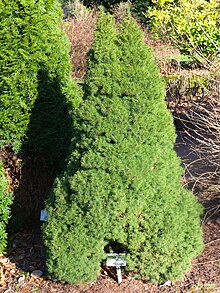Sugarloaf spruce
The Sugar spruce ( Picea glauca var. Albertiana 'Conica') is a dwarf cultivar of from North America derived white spruce , 1904 at the Lake Laggan was discovered in Canada.
The sugar loaf spruce is a very popular garden plant in Central Europe . It is very slow-growing (2 to 10 cm growth per year) and becomes about 1.5 meters high in 15 years. In the garden it is suitable for sunny to partially shaded locations and is hardy. It is also suitable as a container plant. It prefers moist soil and a slightly cooler place in the garden. It is more easily attacked by pests in dry locations.
The name comes from the growth form, which is similar to the form of sugar in the 19th century . Well clear, for example, in a related species such as the blue sugarloaf spruce ( Picea glauca "Blue Wonder" ). Their strictly conical shape is even more similar to a sugar loaf. Depending on the UV radiation, their shoots shimmer blue-green to steel blue.
Individual evidence
- ↑ Picea species in the Botanical Garden. Botanical Garden of the University of Tübingen, accessed on January 25, 2020 .
- ↑ a b University of Kassel: Sugar Loaf spruce. Retrieved January 25, 2020 .

